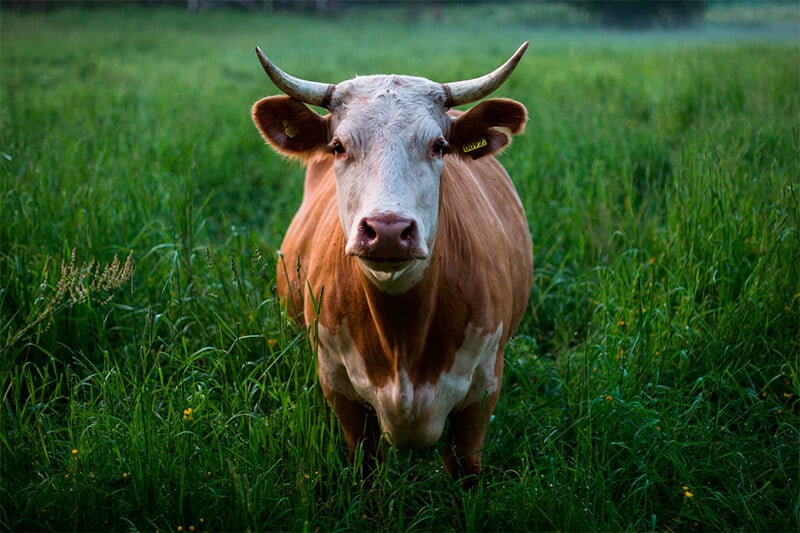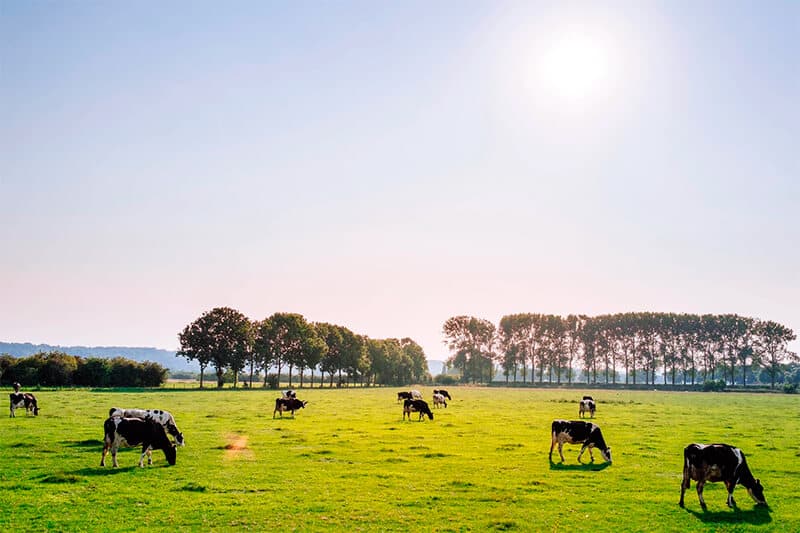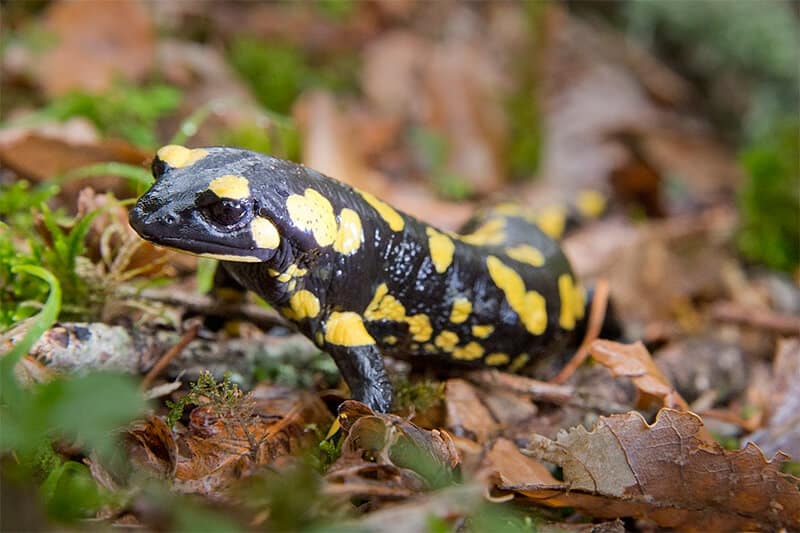Cow Facts: Characteristics, Behavior, and Surprising Information
The cow (Bos primigenius taurus) is one of the most important domesticated animals in the world. It is raised in many countries for valuable natural resources such as milk, meat, and leather. In India, the cow is considered a sacred animal with deep cultural and religious significance. This species was first domesticated in Asia around 7,000 years ago, descending from the aurochs—a large wild bovine native to Africa and Eurasia, known for its thick fur and long, curved horns.
It is estimated that there are over 1.5 billion cows globally today. While most cows are raised by farmers, some populations, like the red cow, may still live in the wild.
Cow seen from the front
Cow Characteristics
The cow is a large, hoofed mammal known for its robust body and grazing lifestyle. Cows typically live in herds of 40 to 50, spending most of their day feeding on grasses and shrubs in open pastures. While the size and shape of their horns vary by breed, modern cows are no longer hornless in the wild, as hornless types have been bred out through selective genetics.
The weight of a cow depends largely on the breed. Smaller adult breeds like Dexter and Jersey cows weigh between 270 and 450 kilograms, while larger breeds such as Charolais, Marchigiana, Belgian Blue, and Chianina can reach weights of 635 to 1,150 kilograms. In all breeds, bulls are typically heavier than cows by several hundred kilograms.
Physically, cows have large heads with a pair of hollow horns on each side. They possess short, thick necks and a noticeable dewlap (a hanging fold of skin) below the chest. One distinctive feature of the cow compared to other bovines is its long tail, which ends in a tuft of coarse hair used to swat away insects. Their backs are generally straight, with slightly arched loins, and female cows have a prominent udder in the rear underside of the body, containing four nipples for milk production.
A cow’s body is covered in short hair that varies in color from white to black, including many shades of brown and red. Some breeds have unique patterns or patches, while others display a solid color with contrasting areas of pigmentation.
From an environmental perspective, cows play a significant role in greenhouse gas emissions. It is estimated that 18% of global greenhouse gases come from livestock, with cows being major contributors due to their production of methane gas, primarily through belching and flatulence.
Cow Vision and Eyesight
Vision is the most dominant sense in cattle, accounting for around 50% of the sensory information they process. Their eyes are positioned on the sides of the head, giving them a wide 330º field of view, which helps detect predators from almost all directions. However, this adaptation limits their binocular vision to just 30º to 40º, compared to the 140º range seen in humans. As a result, they have a blind spot directly behind them. Although their visual acuity is decent, it is significantly less sharp than human vision.
A common misconception is that bulls are enraged by the color red, as often portrayed in bullfighting. In reality, cattle are color-blind to red, and it’s the movement of the fabric, not the color itself, that triggers a reaction. This misunderstanding has persisted due to cultural practices rather than scientific evidence.
Cow Taste Sensitivity and Preferences
Cattle possess a highly developed sense of taste, supported by approximately 20,000 taste buds, which allow them to distinguish the four primary flavors: sweet, salty, bitter, and sour. They instinctively avoid bitter-tasting substances, as these may indicate potential toxicity in certain plants. In contrast, they show a strong preference for sweet and salty flavors, which are more palatable and nutritious.
Since plants are naturally low in sodium, these animals have adapted to seek out salt using both their taste and smell receptors. When sodium levels are deficient, they rely on their acute olfactory and gustatory senses to identify even trace amounts of salt-containing food sources, ensuring their dietary needs are met.
Cow Hearing and Sound Perception
Cattle have a fairly sharp sense of hearing, even more acute than that of horses. However, their acoustic acuity threshold is around 30º, which makes them less precise in locating sound sources compared to goats (18º), dogs (8º), and humans (0.8º). It is believed that their wide 330º field of vision reduces the need to turn their heads toward a sound, as they can already visually monitor their surroundings.
Vocalizations, particularly low-frequency moos, serve as a key form of communication among individuals in a herd. These sounds can convey various types of information, including age, sex, and reproductive status. For example, calves use vocal cues to locate their mothers, while males may vocalize during mating season to signal dominance or attract attention from females.
How the Cow’s Digestive System Works ?
As ruminant animals, cattle have a highly specialized digestive system designed to efficiently process a wide variety of plant-based foods. Contrary to the common belief that they possess four stomachs, they actually have one stomach divided into four distinct compartments: the rumen, reticulum, omasum, and abomasum. The rumen, the largest section, serves as a fermentation chamber, while the reticulum, often called the “honeycomb,” plays a key role in trapping and collecting smaller particles.
The omasum is responsible for absorbing water and nutrients, and the abomasum—known as the “true stomach”—functions similarly to the human stomach, secreting digestive enzymes to break down food.
One of the unique features of ruminants is their ability to regurgitate and re-chew partially digested food, a process known as rumination. Initially, food is swallowed with minimal chewing and stored in the rumen. Later, when the animal is at rest, the food is brought back up, chewed thoroughly, and digested more effectively.
The rumen is home to billions of beneficial microbes that help break down cellulose and complex carbohydrates found in plant matter. These microbes not only aid in energy extraction but also become a source of high-quality protein when digested by the host.
Behavior and Temperament in Cattle of Cow
Ear posture in cattle serves as a clear indicator of their emotional state and overall well-being. Temperament plays a crucial role in livestock management, as it can directly impact the quality of meat, milk production, and reproductive success. When an individual is under stress, other animals in the herd can detect changes through chemical signals present in the urine.
Short-term isolation can cause significant psychological distress, especially in social animals like cattle. To minimize stress during necessary periods of separation, mirrors are sometimes placed in enclosures. These reflective surfaces help simulate the presence of other herd members, reducing anxiety and promoting calm behavior.
Habitat and Farming Systems
Today, cattle are found all over the world, reflecting their vital role in agriculture and human livelihoods. These animals are raised under two primary farming systems: intensive and extensive. In intensive farming, animals—particularly dairy breeds—are kept on large-scale farms where conditions are closely managed to maximize milk production. In contrast, extensive systems involve raising livestock for beef, typically allowing them to graze freely in open pastures and natural environments.
Feeding Habits of Cows
As herbivores, these grazing animals primarily feed on grass, but their diet also includes stems, leaves, seeds, and roots from a wide variety of plants. They spend a significant portion of the day—up to eight hours—engaged in feeding. This natural behavior supports their ruminant digestive system, which is specifically adapted to break down tough plant fibers and extract essential nutrients.
Cows feeding on grass
Natural Predators of the Cows
The primary predator of cattle is the human, due to widespread domestication and farming practices. However, in the wild and rural areas, these animals can also fall prey to various carnivores across different continents. In North America, wolves and grizzly bears occasionally attack livestock. In Asia, predators such as tigers and regional wolf species have been known to target grazing herds.
Across parts of Africa, lions and leopards are among the main threats, especially in regions where livestock graze near natural reserves. In Australia, the dingo, a native wild dog, sometimes hunts young or isolated animals, posing a risk to local cattle populations.
Reproduction and Breeding in Cattle
Cattle have the ability to interbreed with closely related species such as yaks and bison, producing viable hybrids that are often raised for specific agricultural purposes. However, crossbreeding with buffalo is not possible due to significant genetic differences.
Reproduction can occur year-round, though spring is considered the optimal season, as it typically results in a higher number of calves born. The gestation period lasts approximately nine months, after which a single calf is usually delivered, weighing between 25 and 45 kilograms, depending on the breed. Young animals are referred to as calves until they are about two to three years old, at which point males are known as bulls and females continue as breeding stock.
Both males and females reach sexual maturity within their first year of life. A healthy female can continue to reproduce until around 12 years of age. In modern livestock farming, breeding may occur naturally or through artificial insemination, a widely used method to improve genetic traits and ensure reproductive efficiency.
Conservation Status
Overall, cattle are not considered at risk and are classified as a species of Least Concern on the conservation scale. However, certain breeds face the threat of extinction due to changes in agricultural practices and declining demand. One example is the red cattle breed, historically used for farm labor, which has seen a significant population decline in recent decades.
Relationship with Humans
Since domestication, cattle have played a vital role in human civilization, primarily as a source of essential products such as milk, meat, and leather. Beyond fresh milk, a wide variety of dairy products—including cheese, butter, and yogurt—are derived from cattle, making them a cornerstone of agriculture, nutrition, and trade in many cultures around the world.
Milk Production and Its Global Impact
Milk production begins only after a female has given birth and continues as long as she is milked regularly. The resulting milk is a nutrient-rich food source, offering high levels of calcium, phosphorus, magnesium, zinc, iodine, selenium, and essential vitamins such as A, D, and B12. On average, a dairy animal can produce around 4,000 liters of milk per year, though high-yielding breeds may exceed 10,000 liters annually.
During the 20th century, especially in Europe, milk became a staple in middle-class households, leading to a surge in demand. This growth pushed dairy farms to adopt more efficient production systems, focusing on both quantity and hygiene. A key innovation in this process was the development of UHT (Ultra-High Temperature) treatment, also known as ultrapasteurization, which allows milk to be stored safely by eliminating harmful microorganisms without refrigeration.
Despite its nutritional value, excessive milk consumption has raised health concerns, particularly for individuals with lactose intolerance. Fortunately, modern dairy processing now includes lactose-free milk options, making dairy accessible to a wider audience.
Milk is also the foundation for numerous dairy products, including cheese, butter, yogurt, and cream. Behind these items lies a massive global dairy industry responsible for production, processing, and distribution to markets worldwide.
Other Products Derived from the cows
In addition to dairy, cattle are raised for beef production, with specific breeds such as Hereford and Charolais selectively bred for their high-quality meat. These breeds are known for their superior marbling, texture, and flavor, making them highly valued in the meat industry.
Beyond meat, the hide is processed into leather, which is widely used in the manufacturing of coats, shoes, bags, and other durable goods. Similar to the dairy sector, a large-scale global industry supports the processing, production, and distribution of beef and leather products, contributing significantly to the agricultural economy.
A cow produces more than 50 liters of manure a day that is used as compost and fuel.
Cattle in Popular Culture, Religion, and Folklore
In Hinduism, particularly in India, the cow holds a deeply revered status and is considered divine and satvik, symbolizing purity, non-violence, and maternal care. While historically there were periods of mass slaughter, today these animals are protected and respected, reflecting their sacred place in Indian society. According to the Mahabharata, they should be honored with the same reverence given to one’s mother.
Cattle appear frequently in Hindu scriptures such as the Vedas and Puranas, although they do not have dedicated temples. The deity Krishna, who was raised by cowherds, is also known as Govinda, meaning “protector of cows.” Additionally, Lord Shiva is traditionally depicted riding Nandi, a sacred bull that serves as his vehicle. In modern-day India, the slaughter of cattle, including bulls, oxen, and calves, is strictly prohibited under the laws of the Indian Union.
Outside of India, cattle also play a role in East Asian traditions. In the Chinese zodiac, the ox is one of the twelve symbolic animals, representing strength, reliability, and patience in the lunar calendar cycle.
Source: Ruminant – Wikipedia




